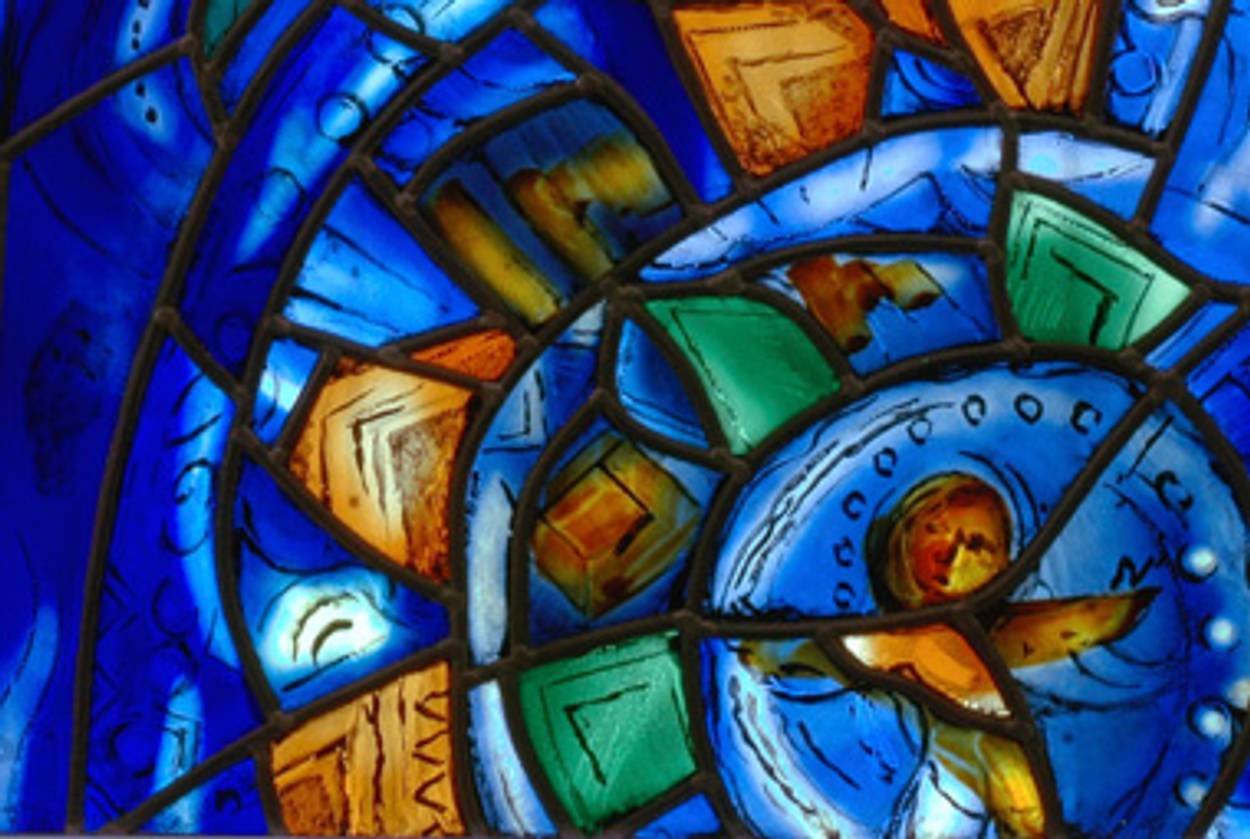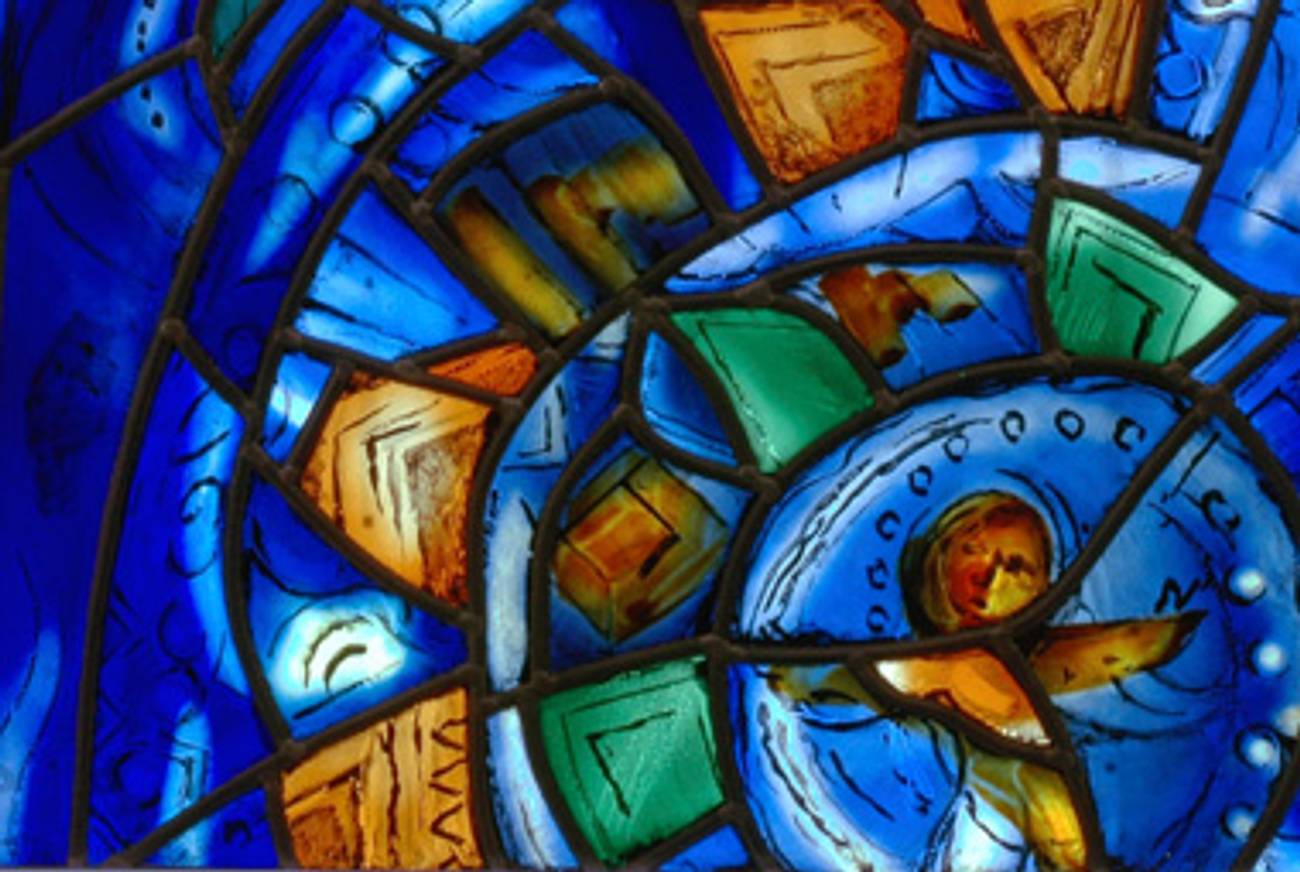Rhapsody in Blue
Newly restored, Chagall’s America Windows—conceived in honor of the 1976 bicentennial and popularized in Ferris Bueller’s Day Off—sparkle as never before




The first time that I saw Chagall’s America Windows at the Art Institute in Chicago, about 20 years ago, I can’t say that they blew me away. Yes, the blue was magnificent, as always with Chagall, but this work, installed when Chagall was 90, appeared to me then to have some of the elements that once led the critic Robert Hughes, waxing a little more nasty than nice, to describe the artist’s late productions as “quasi-religious imagery, modular and diffuse at the same time [that] would serve (with adjustments: drop the flying cow, put in a menorah) to commemorate nearly anything, from the Holocaust to the self-celebration of a bank.”
Maybe I’ve lost my edge, but they don’t seem that way to me now.
Back in 1977, when the windows were installed, the self-celebration was America’s, the work had been planned for the 1976 Bicentennial and conceived as a special gift to Chicago’s Mayor Richard Daley, a man better known for encouraging his law enforcement officers to test their billy-clubs out on Yippies than for his adoration of the vitreous harmonics of stained glass. Daley died in May 1976 before he could see the windows in situ.
In June 1986, the windows got a big lift when Ferris Bueller and his inamorata, Sloane, stood in awe before them during a time-out on his energetic day off. The viewing area briefly became a hot dating spot for young Chicagoans. Five years ago the museum, about to begin the construction of a new gallery, dismantled the windows for cleaning and restoration, and late last year, amid much hoopla, they were put back on display, all bright and sparkly.
The major difference in the new installation is that the windows are no longer functioning windows in walls but free standing in front of actual windows. Stephanie D’Alessandro, a curator at the Institute, explained that now “the entire installation is lit with a special internal lighting system … to protect it from the elements and further wear and tear.” In terms of preservation, this is clearly good news; the extraordinarily vibrant blues, yellows, and reds will not fade or accumulate residue of any kind. On the other hand, much as I loved seeing the windows in their new setting, some subtle shift in ambience accrues when they are presented, albeit for good reasons, more like paintings. This is not to say that the soaped up, washed off, and newly nitid panels aren’t stunning.
Chagall became fascinated with stained glass after he had moved to the south of France in 1950. Undoubtedly he was seduced by the endless Mediterranean unfolding of color-as-light and the possibility of capturing in glass the kind of spiritually charged, quasi-mystical, sometimes biblically inspired images to which he was increasingly drawn. Stained glass windows, of course, hooked Chagall up with a powerful Christian tradition, and he was always ambivalent about making that connection. When, in 1949, he was first asked to decorate the baptistery of a French church he both convened a rabbinical advisory board and wrote to Chaim Weizmann to ask if it was OK if he went ahead with the project. Thus, for what you saw by the dawn’s early light while gazing at one of his windows, Chagall was generally after something ecumenical and frequently secular, as in the Chicago America Windows. Luckily for Chagall, André Malraux found a direct, highly flattering, and unthreatening link between the painter and the Christian masters: “I cannot understand,” he wrote, “why stained glass, which lives and dies with the day, was ever abandoned. … Artists preferred the light. But the stained glass window, which is brought to life by the morning and snuffed out by the night, brought the Creation home to the worshiper in church. … Stained glass eventually surrendered to painting by incorporating shade, which killed it. It was six hundred and fifty years before someone found a way of shading off colors in glass: Chagall.”
The America Windows (executed in France with the assistance of master craftsman Charles Marq) are beautiful ghosts of an earlier work by Chagall: the four vertical paintings Music, Dance, Drama, and Literature that he painted for the Moscow Yiddish Theatre (known as “Chagall’s Box”) in the hard, freezing winter of 1920 and that he placed in the spaces between the theater’s windows. These paintings were first moved in 1925 to the foyer of a new theater and then hastily taken down and hidden in 1937 during one of Stalin’s purges. They did not see the light of day again until 40 years later when, in 1973, Chagall made a trip to Russia. There the canvases were unrolled for Chagall to view and sign before the powers that be reconsigned them to Soviet oblivion. Clearly, Chagall had the recently viewed Moscow paintings firmly in mind when he conceived the “America Windows” project in 1974, for the four themes are reiterated in the 36 stained glass panels, which feature trumpets, violins, books, acrobats, and, in a gesture to the lost Jewish past, a lit five-branched menorah in the bottom corner of one window.
The newly cleaned windows dazzle, and the blue goes on forever. In his “Theory of Color” Goethe made the claim that “Blue is a darkness weakened by the light.” His reification of darkness (an attempt to supplant Newton) has caused all modern physics to reject his theory but, beginning with the Pre-Raphaelites, artists have always been drawn to his quirky notions as they open a door to the subjective. Chagall’s blue windows certainly appear to have a life of their own, so much so that you almost imagine you could see them in the dark. Chagall is, after all, a painter who excels at being in at least two places at once. For example, in his representation of city buildings, Chagall invariably manages to replicate the higgledy-piggledy qualities of his native Vitebsk’s shops and houses even as he evokes the monumental structures of a great city, sometimes Paris, or in this case, Chicago—a Chicago, it should be pointed out, in which the Statue of Liberty has mysteriously floated west to hold her lamp over what looks like Lake Shore Drive.
Ferris famously kissed Sloane in front of the America windows. You can’t get a better seal of approval.
Jonathan Wilsonis the director of the Center for the Humanities at Tufts University. His books include the novel A Palestine Affair, the story collection An Ambulance Is On the Way, and, from Nextbook Press, the biography Marc Chagall.
Jonathan Wilson is the author of eight books including the novel A Palestine Affair and a biography, Marc Chagall. He recently completed a novel, Hotel Cinema, about the unsolved murder of Chaim Arlosoroff.